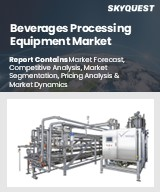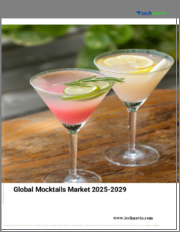
|
시장보고서
상품코드
1607706
비알코올 음료 시장 규모, 점유율, 성장 분석, 제품별, 유통 채널별, 지역별 - 산업 예측(2024-2031년)Non-Alcoholic Beverages Market Size, Share, Growth Analysis, By Product (Carbonated Soft Drinks, Bottled Water), By Distribution channel, By Region - Industry Forecast 2024-2031 |
||||||
세계의 비알코올 음료 시장 규모는 2022년에 9,940억 1,000만 달러에 달하며, 2023년 1조 773억 5,000만 달러에서 2031년에는 1조 8,799억 1,000만 달러로 성장하며, 예측 기간(2024-2031년)의 CAGR은 8.56%로 성장할 전망입니다.
세계의 음료 업계는 현재 시장의 50% 이상을 차지하는 비알코올 음료의 문화적·사회적 중요성의 증가에 의해 촉진되며 변혁기를 맞이하고 있습니다. 이러한 성장 추세는 청량음료에 대한 소비자의 관심이 증가하고 일상 생활에 침투하고 있음을 보여줍니다. 또한 무역 제한과 관세 장벽의 완화로 인해 제조업체들이 세계 생산 능력을 강화하는 추세입니다. 신흥 시장의 확대와 소비자 선호도 변화, 특히 혁신적인 제품 출시로 인해 향후 수년간 큰 성장 기회가 있을 것으로 예상됩니다. 투자자들은 음료 산업의 역동적인 상황과 비알코올 음료의 미래에 대한 귀중한 인사이트을 보여주는 이러한 변화에 주목해야 합니다.
목차
서론
- 조사의 목적
- 조사 범위
- 정의
조사 방법
- 정보 조달
- 2차 데이터와 1차 데이터 방법
- 시장 규모 예측
- 시장의 전제조건과 제한
개요
- 세계 시장 전망
- 공급과 수요의 동향 분석
- 부문별 기회 분석
시장 역학과 전망
- 시장 개요
- 시장 규모
- 시장 역학
- 촉진요인과 기회
- 억제요인과 과제
- Porter의 산업 분석과 영향
- 경쟁 기업 간 경쟁 관계
- 대체품의 위협
- 바이어의 교섭력
- 신규 진출업체의 위협
- 공급 기업의 교섭력
주요 시장 인사이트
- 주요 성공 요인
- 경쟁의 정도
- 주요 투자 기회
- 시장 에코시스템
- 시장의 매력 지수(2023년)
- PESTEL 분석
- 거시경제 지표
- 밸류체인 분석
- 가격 분석
- 기술의 진보
- 규제 상황
- 사례 연구
- 고객과 구매 기준 분석
- 무역 분석
- 스타트업 분석
- 원재료 분석
비알코올 음료 시장 규모 : 제품별 & CAGR(2024-2031)
- 시장 개요
- 탄산음료
- 생수
- RTD 홍차·커피
- 기능성 음료
- 주스
- 유제품 음료
- 기타
비알코올 음료 시장 규모 : 유통 채널별 & CAGR(2024-2031)
- 시장 개요
- 슈퍼마켓/하이퍼마켓
- 식품 서비스 부문
- 편의점
- 전문점
- 온라인 소매
비알코올 음료 시장 규모 : 지역별 & CAGR(2024-2031)
- 북미
- 미국
- 캐나다
- 유럽
- 영국
- 독일
- 스페인
- 프랑스
- 이탈리아
- 기타 유럽 지역
- 아시아태평양
- 중국
- 인도
- 일본
- 한국
- 기타 아시아태평양
- 라틴아메리카
- 브라질
- 기타 라틴아메리카 지역
- 중동 및 아프리카
- GCC 국가
- 남아프리카공화국
- 기타 중동 및 아프리카
경쟁 정보
- 상위 5사의 비교
- 주요 기업의 시장 포지셔닝(2023년)
- 주요 시장 기업이 채택한 전략
- 시장의 최근 동향
- 기업의 시장 점유율 분석(2023년)
- 주요 기업의 기업 개요
- 회사 개요
- 제품 포트폴리오 분석
- 부문별 점유율 분석
- 매출의 전년대비 비교(2021-2023)
주요 기업 개요
- PepsiCo Inc.
- The Coca-Cola Company
- Danone S.A.
- Nestle S.A.
- Red Bull GmbH
- Keurig Dr Pepper Inc.
- Parle Agro
- Monster Beverage Corporation
- AriZona Beverages USA
- Suntory Beverage & Food Ltd.
- Asahi Group Holdings, Ltd.
- Unilever
- Jones Soda Co.
- IBS Partners Ltd.
- National Beverage Corp.
- Celsius Holdings, Inc.
- Vita Coco Company
- Fever-Tree
- Bolthouse Farms
- PerfectTed
결론과 권장사항
KSA 24.12.30Global Non-alcoholic Beverages Market size was valued at USD 994.01 billion in 2022 and is poised to grow from USD 1077.35 billion in 2023 to USD 1879.91 billion by 2031, growing at a CAGR of 8.56% in the forecast period (2024-2031)
The global beverage industry is undergoing a transformative shift, driven by the increasing cultural and social significance of non-alcoholic beverages, which now represent over 50% of the market. This growing trend highlights the rising consumer interest in refreshing drinks and their integration into daily lifestyles. Furthermore, reduced trade restrictions and tariff barriers are encouraging manufacturers to enhance production capacities on a global scale. As emerging markets expand and consumer preferences evolve, particularly with the introduction of innovative products, significant growth opportunities are anticipated in the coming years. Investors should closely monitor these shifts, as they present valuable insights into the dynamic landscape of the beverage industry and the future of non-alcoholic beverages.
Top-down and bottom-up approaches were used to estimate and validate the size of the Global Non-Alcoholic Beverages market and to estimate the size of various other dependent submarkets. The research methodology used to estimate the market size includes the following details: The key players in the market were identified through secondary research, and their market shares in the respective regions were determined through primary and secondary research. This entire procedure includes the study of the annual and financial reports of the top market players and extensive interviews for key insights from industry leaders such as CEOs, VPs, directors, and marketing executives. All percentage shares split, and breakdowns were determined using secondary sources and verified through Primary sources. All possible parameters that affect the markets covered in this research study have been accounted for, viewed in extensive detail, verified through primary research, and analyzed to get the final quantitative and qualitative data.
Global Non-Alcoholic Beverages Market Segmental Analysis
Global Non-Alcoholic Beverages Market is segmented by Product, Distribution Channel and region. Based on Product, the market is segmented into Carbonated Soft Drinks, Bottled Water, RTD Tea & Coffee, Functional Beverages, Juices, Dairy-based Beverages, Others. Based on Distribution Channel, the market is segmented into Supermarkets/Hypermarkets, Food Services Sector, Convenience Stores, Specialty Stores, Online Retails. Based on region, the market is segmented into North America, Europe, Asia Pacific, Latin America and Middle East & and Africa.
Driver of the Global Non-Alcoholic Beverages Market
The growth of e-commerce platforms is poised to be a major driver for the global non-alcoholic beverages market. As consumer reliance on internet shopping continues to escalate, the drinks sector is experiencing significant shifts due to technological advancements and changing shopping habits. According to the Worldwide E-commerce Foundation, internet users have been steadily increasing, with e-commerce accounting for nearly 30% of total grocery sales as of 2018-a figure expected to rise in the future. Consequently, beverage manufacturers are heavily investing in the establishment of innovative online platforms to capitalize on this trend, fostering industry growth in the coming years.
Restraints in the Global Non-Alcoholic Beverages Market
The global non-alcoholic beverages market faces challenges due to fluctuations in the availability and pricing of essential natural resources. Since this industry relies heavily on resources such as water and electricity, social and environmental issues often arise, including indirect greenhouse gas emissions, diminishing water supplies, and increased pollution. These disturbances hinder the supply chain and are likely to negatively affect production capacities within the market. In response to these sustainability challenges, major manufacturers, including The Coca-Cola Company and PepsiCo, have collaborated with the alcoholic beverage sector to form the Beverage Industry Environmental Roundtable (BIER), aiming to promote better sustainability practices across the industry.
Market Trends of the Global Non-Alcoholic Beverages Market
The Global Non-Alcoholic Beverages market is witnessing a transformative trend driven by escalating consumer interest in health and wellness. As millennials and younger generations seek nutrient-rich, healthier options, manufacturers are compelled to innovate, introducing diverse beverages that align with these evolving preferences, such as natural sodas and functional drinks. This adventurous consumer base is not only open to experimenting with new flavors but also prioritizes transparency and sustainability in sourcing. Consequently, companies are redefining product formulations and exploring new manufacturing techniques, fostering a dynamic market environment that caters to the growing demand for health-conscious non-alcoholic beverages worldwide.
Table of Contents
Introduction
- Objectives of the Study
- Scope of the Report
- Definitions
Research Methodology
- Information Procurement
- Secondary & Primary Data Methods
- Market Size Estimation
- Market Assumptions & Limitations
Executive Summary
- Global Market Outlook
- Supply & Demand Trend Analysis
- Segmental Opportunity Analysis
Market Dynamics & Outlook
- Market Overview
- Market Size
- Market Dynamics
- Driver & Opportunities
- Restraints & Challenges
- Porters Analysis & Impact
- Competitive rivalry
- Threat of substitute
- Bargaining power of buyers
- Threat of new entrants
- Bargaining power of suppliers
Key Market Insights
- Key Success Factors
- Degree of Competition
- Top Investment Pockets
- Market Ecosystem
- Market Attractiveness Index, 2023
- PESTEL Analysis
- Macro-Economic Indicators
- Value Chain Analysis
- Pricing Analysis
- Technological Advancement
- Regulatory Landscape
- Case Studies
- Customer & Buying Criteria Analysis
- Trade Analysis
- Startup Analysis
- Raw Material Analysis
Global Non-Alcoholic Beverages Market Size by Product & CAGR (2024-2031)
- Market Overview
- Carbonated Soft Drinks
- Bottled Water
- RTD Tea & Coffee
- Functional Beverages
- Juices
- Dairy-based Beverages
- Others
Global Non-Alcoholic Beverages Market Size by Distribution Channel & CAGR (2024-2031)
- Market Overview
- Supermarkets/Hypermarkets
- Food Services Sector
- Convenience Stores
- Specialty Stores
- Online Retails
Global Non-Alcoholic Beverages Market Size & CAGR (2024-2031)
- North America, (Product, Distribution Channel)
- US
- Canada
- Europe, (Product, Distribution Channel)
- UK
- Germany
- Spain
- France
- Italy
- Rest of Europe
- Asia-Pacific, (Product, Distribution Channel)
- China
- India
- Japan
- South Korea
- Rest of Asia Pacific
- Latin America, (Product, Distribution Channel)
- Brazil
- Rest of Latin America
- Middle East & Africa, (Product, Distribution Channel)
- GCC Countries
- South Africa
- Rest of Middle East & Africa
Competitive Intelligence
- Top 5 Player Comparison
- Market Positioning of Key Players, 2023
- Strategies Adopted by Key Market Players
- Recent Developments in the Market
- Company Market Share Analysis, 2023
- Company Profiles of All Key Players
- Company Details
- Product Portfolio Analysis
- Company's Segmental Share Analysis
- Revenue Y-O-Y Comparison (2021-2023)
Key Company Profiles
- PepsiCo Inc.
- Company Overview
- Business Segment Overview
- Financial Updates
- Key Developments
- The Coca-Cola Company
- Company Overview
- Business Segment Overview
- Financial Updates
- Key Developments
- Danone S.A.
- Company Overview
- Business Segment Overview
- Financial Updates
- Key Developments
- Nestle S.A.
- Company Overview
- Business Segment Overview
- Financial Updates
- Key Developments
- Red Bull GmbH
- Company Overview
- Business Segment Overview
- Financial Updates
- Key Developments
- Keurig Dr Pepper Inc.
- Company Overview
- Business Segment Overview
- Financial Updates
- Key Developments
- Parle Agro
- Company Overview
- Business Segment Overview
- Financial Updates
- Key Developments
- Monster Beverage Corporation
- Company Overview
- Business Segment Overview
- Financial Updates
- Key Developments
- AriZona Beverages USA
- Company Overview
- Business Segment Overview
- Financial Updates
- Key Developments
- Suntory Beverage & Food Ltd.
- Company Overview
- Business Segment Overview
- Financial Updates
- Key Developments
- Asahi Group Holdings, Ltd.
- Company Overview
- Business Segment Overview
- Financial Updates
- Key Developments
- Unilever
- Company Overview
- Business Segment Overview
- Financial Updates
- Key Developments
- Jones Soda Co.
- Company Overview
- Business Segment Overview
- Financial Updates
- Key Developments
- IBS Partners Ltd.
- Company Overview
- Business Segment Overview
- Financial Updates
- Key Developments
- National Beverage Corp.
- Company Overview
- Business Segment Overview
- Financial Updates
- Key Developments
- Celsius Holdings, Inc.
- Company Overview
- Business Segment Overview
- Financial Updates
- Key Developments
- Vita Coco Company
- Company Overview
- Business Segment Overview
- Financial Updates
- Key Developments
- Fever-Tree
- Company Overview
- Business Segment Overview
- Financial Updates
- Key Developments
- Bolthouse Farms
- Company Overview
- Business Segment Overview
- Financial Updates
- Key Developments
- PerfectTed
- Company Overview
- Business Segment Overview
- Financial Updates
- Key Developments



















